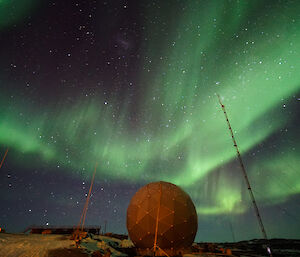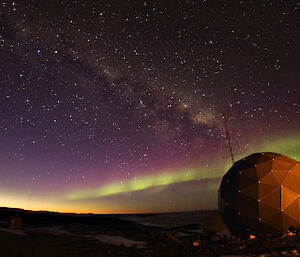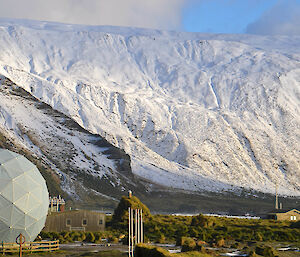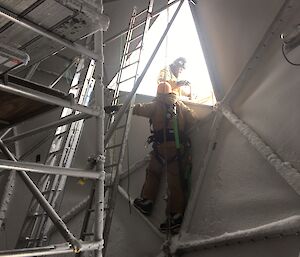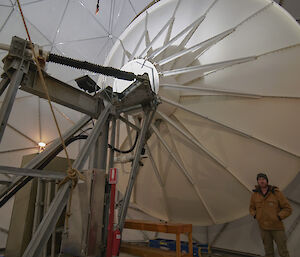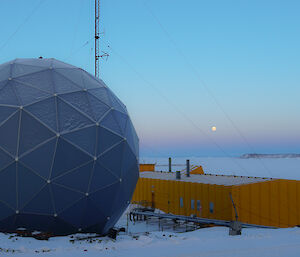A question I’ve been asked when sharing photos online of station is — ‘what’s that giant ball?' It’s certainly a unique structure that you’re unlikely to come across back in Australia.
The structure is a ‘radome’ that houses the antenna for our Australian National Antarctic Research Expeditions Satellite (ANARESAT) ground station. In populated areas around the world, cables link our homes, offices and the mobile phone towers we use that keep us connected. In remote areas it’s not feasible to run undersea fibre optic cables so we use satellites orbiting the earth to carry our communications through radio waves.
The dome is ‘geodesic’ making it self-supporting and strong, rated for forces up to 320km/h, so it can withstand the extremes of an Antarctic blizzard. The panels are made out of a special membrane material, so the radio waves pass freely though; steel which clads the other buildings on station would block the signal. The panels do occasionally get damaged by flying debris and need to be replaced, luckily this is not common at Davis.
Inside the 12 meter radome a 7.3 meter antenna (a parabolic dish) transmits radio waves to a satellite orbiting some 36,000km above the earth’s surface. At this height the satellite is in a ‘geosynchronous orbit’ — it maintains the same position above the surface as the earth rotates so to us appears stationary. The satellite re-transmits the signal down to another earth station (the ‘anchor’) in Perth where it makes a leisurely trip across to Tasmania on those cables mentioned earlier — Amazing!
In the early days of Antarctic exploration before facilities like the ANARESAT, HF radio was used to link our Antarctic bases to the rest of the world. Radio operators would transmit short messages via morse code. Then came voice over the HF radio, and the reception of messages was aided by telex — a machine would print the received message to tape.
Davis was the first station to have the ANARESAT installed in March 1987. Initially it allowed for one phone call, and one 4800 bit-per-second data line. Over the years it has been progressively upgraded to what we currently have, a 9 Mega bit-per-second link — 1875 times more capacity.
Now science instruments transmit data real time, we make phone and video calls, and connect with our families and friends better than ever through extensive WiFi on station. If something doesn’t look quite right with a piece of equipment a second opinion and some tips can quickly come from supervisors in Kingston. A friendly rivalry is maintained with the other bases through a game of darts over a video link. Most importantly, the Doctor can connect with specialised medical advice through the use of a state-of-the-art telemedicine suite — all made possible by the ANARESAT system.
Technology certainly changes rapidly and revolutionises how we do things, one of the true joys of working in the Telecommunications industry.



